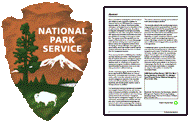United States National Park Service

United States National Park Service: Publications
Date of this Version
2008
Citation
DOI Departmental Consulting Archeologist/NPS Archeology Program, National Park Service, Washington, DC, November 2008.
Abstract
In the United States and elsewhere, efforts to strengthen communities and democratic processes, as well as promote public dialogue, rely upon active citizen engagement in community and civic life through the creation of social capital. Archeology can play a role in these efforts, particularly as archeological projects increasingly involve the communities in which they occur and as archeologists recognize their ethical responsibilities to involve multiple stakeholders. This technical brief provides explanations of civic engagement and social capital as well as case studies and suggestions for ways that archeologists can participate and contribute to the creation of social capital.
What is Civic Engagement?
Definitions of civic engagement vary somewhat, but they have in common the elements of involvement and participation in public life. According to Thomas Ehrlich in Civic Responsibility and Higher Education (2000:vi), “Civic engagement means working to make a difference in the civic life of our communities and developing the combination of knowledge, skills, values and motivation to make that difference. It means promoting the quality of life in a community, through both political and non-political processes.” Civic engagement means building communities by creating or reinforcing relationships between people and promoting a healthy dialogue about, and active participation in, civic life.
Many kinds of institutions have become involved in civic engagement. Institutions of higher education often use service learning initiatives in order to satisfy civic engagement responsibilities. In land managing agencies such as the National Park Service (NPS), civic engagement refers to a long-term effort to build and sustain meaningful communication and partnerships with local communities, park visitors, and a diverse array of stakeholders. These community groups and individuals may play meaningful roles in guiding interpretive and educational programming as well as the planning process.
Civic engagement differs from public involvement in both concept and implementation. Public involvement, sometimes referred to as “consultation,” is a legal requirement of the National Environmental Policy Act (NEPA) and the National Historic Preservation Act (NHPA) planning processes and typically ends when the planning process is complete. Civic engagement, on the other hand, is a sustained effort and activity. It moves beyond the short-term legal requirements of public planning to build and strengthen relationships between people in their communities over an extended time period. An example of public involvement is a community meeting to get input before starting a project. Civic engagement, on the other hand, might incorporate the public meeting, but also include community members before, during and after the project, such as on the planning committee and in partnerships with local organizations to leverage funds, to determine the scope of a project, find volunteers, gather and disseminate information, and build interest in heritage or history opportunities beyond the “usual suspects.” Civic engagement can thus strengthen public understanding of the full meaning and contemporary relevance of both cultural and natural resources.

